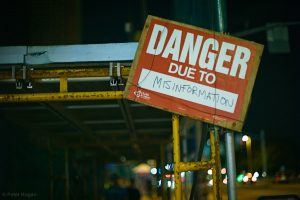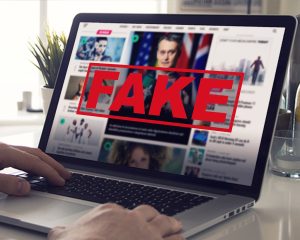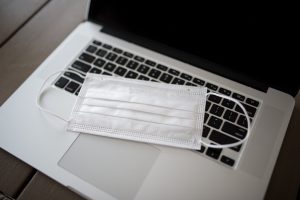21
Blake Moore
This chapter has a lot of potential, but right now, I’m just not seeing how the sources back up the assertions about misinformation. For example, there are no citations any of the sources to back up the ideas. I’m also a bit worried that the thesis lacks clarity. The images do not have alt text and they are not properly labeled. You have good sources, but not enough for the kind of argument you are making.
Introduction
Today, tens of thousands of Americans will be diagnosed with COVID-19, however this could be easily prevented if Americans simply had a better understanding of the virus. Misinformation about the effectiveness of wearing a mask to limit the spread of COVID-19 was spread most widely on social media and popular, biased news networks because of the access society has to online information.
Connection to STS Theory
Right now, advances in technology and science are centered around implementing new ideas to help slow the spread of COVID-19, however, some members of society are not believing that it is needed, or that it will actually help slow the spread. Misinformation about masks in regards to COVID-19 is one of the main ongoing issues with the virus. The Theory that best suits this is the Deliberative Democracy Theory, which explains that society as a whole must discuss, debate, and decide on dilemmas that affect the public good.
The Risk of Misinformation
Everyone has experienced misinformation, whether it be rumors spread over social media in high school, or by seeing it published by mainstream news outlets such as FOX News or CNN. Furthermore, everyone who has experienced this knows how hard it is to erase the lies and slander formed by misinformation. Scientists at the World Health Organization (WHO) are facing these issues in regards with COVID-19 in America. They have stated that their job of slowing the spread of COVID-19 only gets harder as people begin to believe the misinformation regarding the virus. Spreading misinformation is very easy in today’s society because of society’s connection to the internet, where they are risking being exposed to countless

articles of false information every time they log onto social media or browse untrusted news websites. It is up to society to realize they are being exposed to it, and it is up to them to put a stop to it.
Biased News Today
Society is not fully at fault for spreading misinformation. Biased mainstream news networks also share the blame. For example, FOX News and CNN are both guilty of spreading misinformation. Both networks have published articles that are not entirely true or leave out important pieces of information. People today can look back to December of 2019 to see how biased news can affect people globally by looking at the Chinese government and their false claims about COVID-19 and on how they deemed the situation as under control. Biased news would not be such an issue if people would simply take the article for the full truth.

It is up to society as a whole to realize that these biased news networks have published misinformation and will continue to do so. Furthermore, society must also decide the course of action they will take. They must either hold the news companies responsible for releasing articles of fake news that will harm everyone and push for a reformation on how news articles are published, or they must take every article published, that is not a scholarly article or a reliable source, with a grain of salt and realize that they could be exposed to false news.
Voices of Clemson Undergraduate Students
Misinformation hurts everyone, even the people not exposed to it.
The Split in America

As COVID-19 officially became a global pandemic, the World Health Organization announced a series of guidelines to help slow down the spread of COVID-19. One notable piece of information from the guidelines was to wear a mask. However, as the pandemic has progressed, some people have started questioning or denying the usefulness of wearing a mask, and many also began questioning as to how deadly the virus truly is. Since society is deeply connected through the internet where communicating is at the push of a button, this idea began spreading to more people in society, much like the current pandemic. This resulted in many people not wearing a mask and spreading the virus like a wildfire. Mostly to blame for this issue is the tons of misinformed articles that are easily accessible on the internet. People in society have been exposed to these articles have most likely not taken the time to go back and check to see if it was a reliable source, and decide, based on the misinformation they read, if wearing a mask is effective or not. Through these actions, the American people have been split into mask wearers and non-mask wearers. Both sides are guilty of spreading misinformation and reporting false numbers to back up their side of the debate. However, if society does not calmly discuss and debate this, by backing up their findings with actual facts and not false information, this could mark a very ugly trend for the American People.
Conclusion
Americans are in a very interesting point of history as they battle through the COVID-19 pandemic and also have to battle the misinformation pandemic. Individuals will reflect upon this moment in history decades from now. It is up to society to show these individuals on how both pandemics should be dealt with.
Chapter Questions
- Explain what steps you take before sharing news on social media
Supplementary Materials
References
Howard, J., Huang, A., Li, Z., Tufekci, Z., Zdimal, V., Westhuizen, H., . . . Rimoin, A. (n.d.). Face Masks Against COVID-19: An Evidence Review. Retrieved November 23, 2020, from https://www.preprints.org/manuscript/202004.0203/v1
Pazzanese, C. (2020, May 11). Social media used to spread, create COVID-19 falsehoods. Retrieved November 23, 2020, from https://news.harvard.edu/gazette/story/2020/05/social-media-used-to-spread-create-covid-19-falsehoods/
PubMed. (n.d.). Retrieved November 23, 2020, from https://pubmed.ncbi.nlm.nih.gov/?otool=scculib
Images
“Fake News – Computer Screen Reading Fake News” by mikemacmarketing is licensed under CC BY 2.0
“Protective medical mask on laptop. The end of the pandemic.” by shixart1985 is licensed under CC BY 2.0

